It’s the surprise to 2016 we didn’t expect, but the transformation in Adam Scott’s putting has re-injected him into golf’s elite. Here, Scott details how he did it.
BY ADAM SCOTT
It would be easy to assess my life on the greens and see three different careers: pre-broomstick putter up to 2011, using the broomstick through until late last year and now returning to the short putter in the post-anchored stroke era. However, I tend to think of it as two stages rather than three. There was pre-broomstick and broomstick, certainly, but not post-broomstick at all. I don’t feel like anything I’ve done since stopping using the long putter has been any different.
Why? It feels like I’m still putting with the broomstick. I took all the good attributes I found putting with the long putter and implemented them with a shorter putter. Obviously my grip had to be slightly different and I had to find a comfortable way of holding the putter, but essentially I retained all the technical and fundamental parts that I found key to my putting. It wasn’t very difficult at all; it was just about doing a bit of practice and getting in enough repetitions to have the absolute confidence to play at the highest level. Of course, I think I putted really well straight away coming back to the shorter putter, given the fact I hadn’t hit a putt with it for about five years.
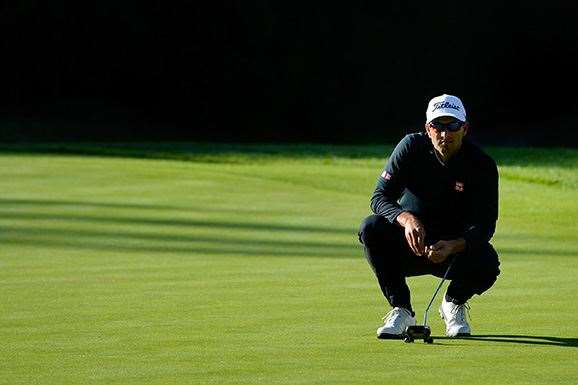 PHOTO: Robert Laberge/Getty Images.
PHOTO: Robert Laberge/Getty Images.Using the broomstick taught me all the basic fundamentals and made putting so simple for me. Of course, there are all the fundamentals with the short putter, too, which have been taught for 100 years or more. But then there are variations of feelings and different things for different people. When you fiddle around with your basic fundamentals a lot then it just leaves more room for error. What putting with the broomstick did was set some of the fundamentals. They couldn’t change because the putter was longer and it was anchored to a point quite high up on my body, which left very little room for change in anything before I took the putter back. There’s very little you can do but rock the shoulders back and through. So it really simplified putting for me and that’s now where my mind sits with that department of the game.
RUMMY, DONALD AND THE CLAW
Mirroring the broomstick was the simple part; finding the right grip was trickier. I tested this kind of split-finger, claw grip and I also used a cross-hand grip but that was about it. Getting comfortable with my grip was really the biggest change because I don’t have my hands far separated like you do on a broomstick. I just had to find a comfortable spot for them. I went back and forth for a couple of weeks between cross-handed and ‘the claw’ and ended up settling on the claw and that’s performed really well.
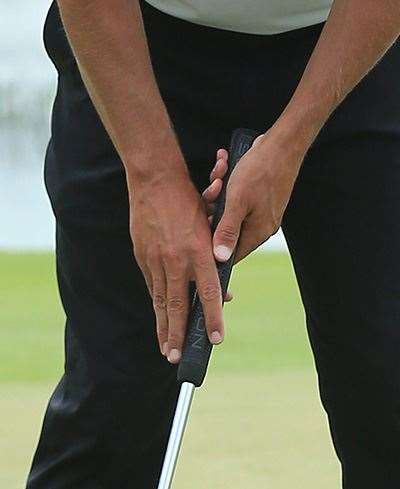 PHOTO: David Cannon/Getty Images.
PHOTO: David Cannon/Getty Images.I did have a little outside help. Brett Rumford and I are good mates and obviously Rummy’s putted with a broomstick a lot so over the past few years we’ve shared some information and feelings on grips. He’s always experimenting with things and there’s been a lot of talk between those of us using an anchored stroke or the broomstick as to what we were going to do beyond 2015. So we were just sharing some different thoughts about it and Rummy showed me a grip he thought was pretty good. I don’t know if he’s using it or not, but it’s worked for me. And that’s the whole thing – it’s just a bit of experimentation on finding a grip that’s comfortable, which is an important part of putting for anyone.
If I were to describe the grip to you, effectively only the left hand holds the club. The right hand’s not even doing anything – there’s no grip pressure in the right hand. I only putt with my left hand and the right hand just sits on there. There are so many versions of the claw but essentially I leave my right thumb and three fingers behind the grip and I just slightly sit my index finger over the top of it. There’s no real pressure and that’s why I refer to it as the ‘split-finger grip’ because my index finger and the other three fingers are split apart, they’re not sitting together. And that’s just a comfortable way for me to hold it. I feel no grip pressure in my right hand and therefore it’ll have no influence on the clubface.
The level of practice I put in to making the transition was probably equivalent to when I initially went to the broomstick. I just started putting and tried not to think too hard about it and I didn’t feel it was that big a deal. I find it amazing that people can think it would be that big a deal because I’ve spent ten years on Tour – and my whole life before that – putting with a short putter and found a way to get it done.
There was another player I observed, too. When I was putting with the broomstick, I always really liked Luke Donald’s rhythm with his putter and that’s something that was easy to emulate with the broomstick because it’s a very long, slow and kind of pendulum swing. In my opinion, Luke’s is quite a pendulum-like action.
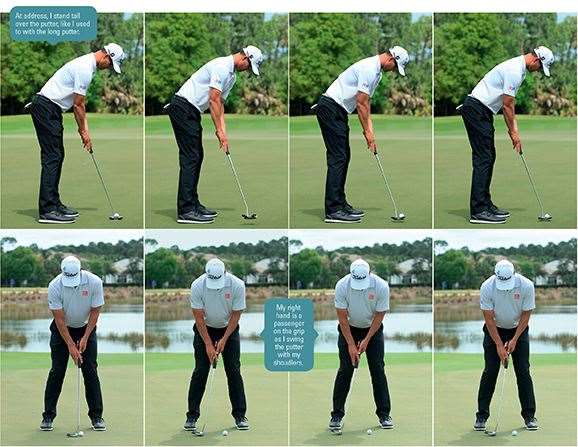
My habits and routine are simple but repeated with precision. In practice, every day I always start by using an aiming board just to make sure I’ve got my eyes aiming where I actually think I am. That’s key in putting, especially when some of the other factors in the way I putt are taken into consideration, like using a high moment-of-inertia putter and therefore the clubface is very square-to-square in the stroke and it’s very hard to manipulate the clubface angle to change the path of the ball. So a lot of the time where I aim it, I’m going to hit it, so I’d better be aiming where I’m thinking to give it a chance. So I check that every day. That alignment board I use is also a mirror so it gives me some kind of reference point of where my eyeline is compared to the ball. It doesn’t have to be perfect, it just needs to be close.
There’s always a margin for change within the body just so it’s in a comfortable place, but if the eyes are close to the ball-to-target line rather than being far away from it, that’s a good thing. The only other thing as far as a feeling goes is to still feel like I have the broomstick connected to my chest, which certainly helps keep my posture nice and tall rather than ever getting slouched.
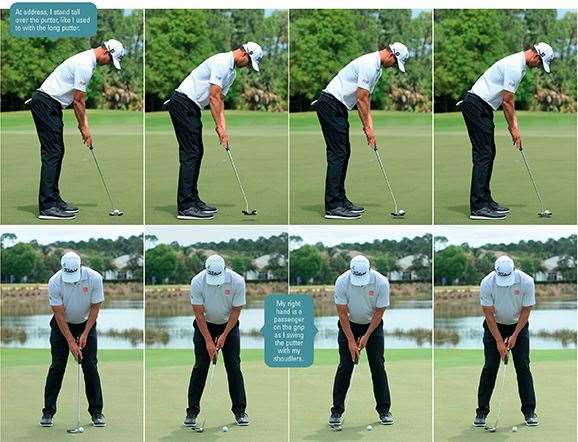
THE ‘BEST PUTTER EVER’
Keegan Bradley led the Valspar Championship after the first round a few days after my back-to-back wins at the Honda Classic and WGC–Cadillac Championship and credited his work on the greens to drawing confidence from my good putting. He’s another who has had to change. We always draw from other people’s performances and you do need that to get motivated, whether it’s a friend of yours doing well that motivates you to play harder, or someone in the same boat as me that’s had to make a big adjustment. Just because I felt switching putting styles was not going to be that big a deal for me, it’s different for some other people who have putted that way their whole careers. I had ten years of reference and experience to fall back on, yet Keegan or Tim Clark or Carl Pettersson had putted their entire careers anchored. Everyone’s going to find their way differently, but if I were in the same boat I’d be drawing on the good feeling of somebody changing and being successful.
The change to the anchoring rule on January 1 had a big deal made about it because it affected a lot of people, which is why it was a hotly debated topic in the game for a while. I just tried to be very clear. In the big picture of things, including the amateur golfer and everything, I still ask, what’s the point? But certainly for me, if it was looked into deeply enough, there would have been less concern or debate about whether I’d putt well or not with a short putter again.
 PHOTO: Drew Hallowell/Getty Images.
PHOTO: Drew Hallowell/Getty Images.Keegan’s words were nice to hear, as was Jack Nicklaus saying during the Honda Classic that I’ve got “a terrific stroke”. I definitely think this stanza of my putting career could be the best yet. Frankly, I don’t see why it can’t be. I’m always trying to get better and better and it’s easy to sit there and say, “Yeah, I’ll be the best putter ever” and then that’s the goal. This is how I felt when I started putting with the broomstick, too. The whole game of golf, when you play the amount that we do, is about confidence and things feeling right and everything being easy. The important thing is to take advantage of that and hopefully all the hard work you do doesn’t allow you to go into such deep valleys of poor performance on the greens or anywhere else. It’s trying to keep it consistently high that’s always the challenge.
Being the best putter in the world remains the goal. After winning twice in Florida, I actually said I wanted to be the best putter in the world by the time the Masters rolled around a month later. I’ve gotten off to a fair start. If I can keep improving, hopefully I can putt at this level or better long-term. You’ve got to set lofty goals if you’re going to achieve anything.
THE STATS MAZE
I recently read where Jordan Spieth’s swing coach, Cameron McCormick, alluded to statistics in golf being like bikinis – the insinuation being that they reveal a lot but not quite everything.
There are so many; some are even confusing. I think Strokes Gained Putting is a very fair stat. It’s the fairest I can think of. Of course, it’s not 100 percent accurate. It’s very hard to be 100 percent accurate in any of those stats, but I guess over the course of a year it all evens out for everyone.
Strokes Gained Putting is a really good way to measure how you’re putting because it takes in to consideration the length of the putt and then measures you at that distance against everybody else. It’s a good stat to look at; I think it gives you a pretty clear idea of how you’re putting. Then there’s putting from three to five feet and four to eight feet and so on; they keep so many different categories. There’s some relevance in that it can clearly point out to you that you’re pretty good out to 15 feet but from 15 to 25 feet you’re just below average on Tour – or whatever it might be. I certainly don’t obsess over it, but if there was a part of my game lacking or if I couldn’t quite put a finger on why I’m not shooting a couple of shots lower, then having all those stats readily available to pull up and just quickly check through, you could probably quickly identify some areas where you’re below average.
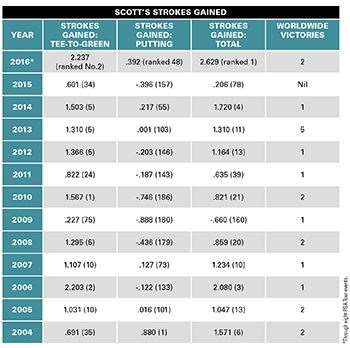 The common perception is that it’s difficult to be a good putter and a leading ball-striker, although I don’t see it that way. With Strokes Gained, if you hit more greens then you’ll probably hit it further away and you’ll have some longer first putts. Obviously there are days when you’ll hit it really close, but if you’re hitting 4-irons on the greens because you’re a good ball-striker you’re not going to be hitting them to ten feet. So if you hit it to 45 feet, the percentage of making that putt is very low. But if you’re not a good ball-striker, you’re not even hitting the green from that range so you can still be a good putter even though you just two-putt from 45 feet all the time. A two-putt from that distance is actually better than what the average guy in the field does. Once you’re outside 32 feet, you’re statistically more likely to three-putt than hole it. So you want to be two-putting a lot from 40 feet and then you’re gaining strokes on the field.
The common perception is that it’s difficult to be a good putter and a leading ball-striker, although I don’t see it that way. With Strokes Gained, if you hit more greens then you’ll probably hit it further away and you’ll have some longer first putts. Obviously there are days when you’ll hit it really close, but if you’re hitting 4-irons on the greens because you’re a good ball-striker you’re not going to be hitting them to ten feet. So if you hit it to 45 feet, the percentage of making that putt is very low. But if you’re not a good ball-striker, you’re not even hitting the green from that range so you can still be a good putter even though you just two-putt from 45 feet all the time. A two-putt from that distance is actually better than what the average guy in the field does. Once you’re outside 32 feet, you’re statistically more likely to three-putt than hole it. So you want to be two-putting a lot from 40 feet and then you’re gaining strokes on the field.
With Strokes Gained, it can actually show that the ball-striker can also be a good putter but you don’t often see a total package of a player. We saw it for a few years with Tiger Woods, who struck it better than everyone and also putted better than everyone and that’s why he won eight tournaments, ten tournaments a year and also by ten shots sometimes. But we don’t often see the total package for whatever reason and I don’t know why; that’s just how it is, it seems. Not too many people put it all together for a long period of time.
Some of the early days with the broomstick were the best I’ve ever rolled it. I had moments early on, even in the first three years with the broomstick, when I felt from ten feet and in was almost automatic – certainly in the first year. I remember making so many more putts than I did, and that’s just relative to me. So that stood out clearly. If you look at the stats, 2004 was the best I’ve ever putted because I was ranked the No.1 putter on the PGA Tour.
Turning a weakness into a strength is a huge goal to achieve in this game and I think I did that when I went to the broomstick. The interesting thing is that in 2004, Strokes Gained Putting wasn’t a stat available then. Mark Broadie, the university professor who came up with the Strokes Gained concept, hadn’t written the algorithm to compute it all yet but that year I recall being about average in putting. The only two stats we had back then were ‘putts per green in regulation’ and ‘putts per round’, and I was about 90th in both of them, so just average. Then the stat was backdated to include Strokes Gained and I ranked first.
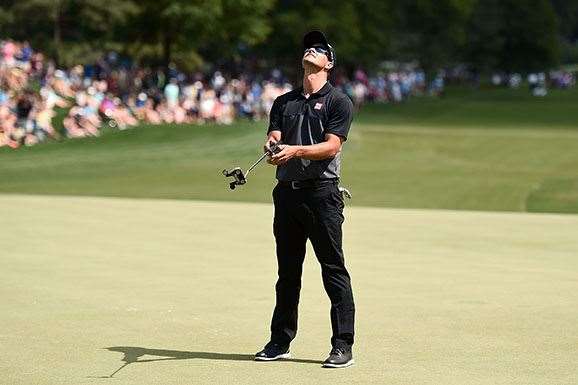 PHOTO: Stacy Revere/Getty Images
PHOTO: Stacy Revere/Getty ImagesThat makes a huge difference in how you perceive yourself as a putter. If everyone talked about me that year as the best putter on Tour then confidence would have come from that … just like for a few years it was clear Luke Donald was the best putter on Tour because he led that stat three years in a row from 2009 to 2011. The confidence showed in his overall game and took him to World No.1. It’s really interesting because obviously I was clearly capable of putting well all those years ago.
Poor putting definitely has the ability to eat backwards through your game and place pressure on the other areas. But conversely, putting well can also lift your tee-to-green play. It goes full circle and it’s the same with the long game as well. When your long game’s on, the putting frees up; if the long game’s off, the putting eventually breaks down because there’s so much pressure on it all the time from missing greens and scrambling. If you’re putting well, you don’t worry about missing a green because you know you’ll chip and one-putt. It’s so key to have it at a high level consistently because then you can walk to the 1st tee every day and know even if you don’t strike it well, you’re going to be able to scramble around for a score. And if you do hit it well, then you’re looking at a good number.
NOT LOOKING BACK
It’s logical to suggest I should have moved to the short putter sooner. I try to not have regrets, and everything’s shaped out pretty well. I don’t know if it would have made a difference or not. I putted with the short putter for those three weeks at the start of last year and it felt pretty good, but I felt like I was making the smarter decision to putt with the broomstick going in to Augusta because I’d won there with it and there was still too much uncertainty with the short one, so I was just going with what I felt and it turned out to be a bit of a frustrating year for me on the greens until I went back to the short putter. But everything just kind of plays out and I don’t think even if I’d switched earlier that I’ve wasted too much time. They’re tough decisions to make and you’ve got to go out and perform against these guys at the highest level. Going to a major last year having done no practice and just playing a few weeks with it, I wasn’t sure that it was going to perform the absolute best.
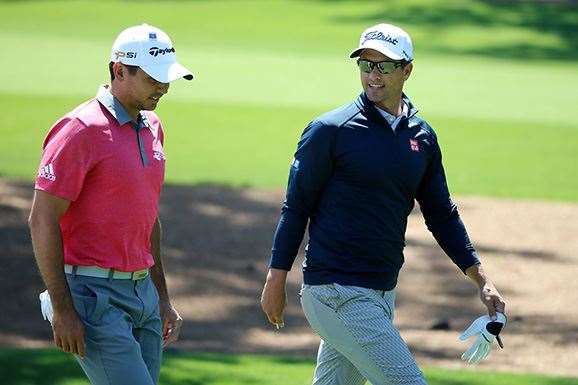 PHOTO: Andrew Redington/Getty Images.
PHOTO: Andrew Redington/Getty Images.In saying that, if the anchoring ban hadn’t come in, I probably would still be using the broomstick putter. There’s been so much focus on putting, the anchoring ban and the noise that’s created around anyone putting that way, it can’t not have had an effect. My putting was solid for four years and interestingly last year it was not, leading to the first season since 2000 (when I turned pro mid-year) that I went winless worldwide. If I continue putting with only the short putter, we’ll never know if that was just part of the cycle that you have of good putting and bad putting. If there were no fuss made about anchored putting and that method carried on, I would think I’d still be using it because I putted consistently well with it for a few years and I don’t know why that would have changed.
In nine weeks last year, Jason Day went from being ranked ninth in the world at the Open Championship to clearly the best player in the world and he nearly won everything he played – in just nine weeks. So much can happen so quickly and a lot goes into it, but for some reason what Jason was able to do in that stretch of golf last year really resonated with me. I had 11 weeks as World No.1 two years ago. I still think I can get back there again and now my putting is back at a level to carry me there.
*Interview with Steve Keipert
Related Articles
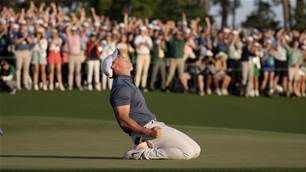
Feature Story: Moving the Needle

The Aussies at The Open













